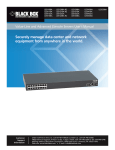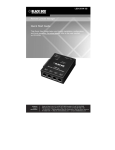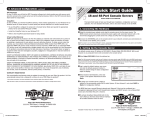Download Black Box Advanced Console Server User`s manual
Transcript
LES1308A, LES1316A LES1332A, LES1348A 8-/16-/32-/48-Port Advanced Console Server with GSM Modem QS Guide Quick Start Guide Securely manage data center and network equipment from anywhere in the world. 8-/16-/32-/48-Port Advanced Console Server Quick Start Guide Trademarks Used in this Manual Black Box and the Double Diamond logo are registered trademarks of BB Technologies, Inc. Cisco is a registered trademark of Cisco Technology, Inc. Linux is a registered trademark of Linus Torvalds. Nagios is a registered trademark of Nagios Enterprises. Any other trademarks mentioned in this manual are acknowledged to be the property of the trademark owners. Page 2 724-746-5500 | blackbox.com 8-/16-/32-/48-Port Advanced Console Server Quick Start Guide This Quick Start Guide walks you through installation, configuration, and local operation or your LES1308A, LES1316A, LES1332A, and LES1348A 8-/16-/32-/48-Port Advanced Console Servers. For more details, please refer to the user’s manual on the CD-ROM. Follow the steps listed below to get started: Step 1: Check kit contents. Your package should contain the following items. If anything is missing or damaged, contact Black Box at 724-746-5500. Console Server (2) UTP cables (1) DB9F-RJ45S straight-through adapter (1) DB9F-RJ45S crossover adapter (1) Antenna with 10 foot extension cable (1) USB micro-AB adapter cable (2) Power cables (1) Rack mount kit with 2 brackets, 6 screws (6) Rubber feet Printed Quick Start Guide User’s manual and SDT connector tool software on CD-ROM Step 2: Connect the hardware. Connect the NETWORK1 port on the Advanced Console Server to your network. Your cellular carrier will provide you with a SIM card. Insert the SIM card (1.) and it will lock into place. Take care to insert SIM card with contacts facing downwards. Screw the external antenna coax cable (2.) onto the MAIN screw mount on the rear of the Advanced Console Server. Figure 1. SIM and Antenna connection. 724-746-5500 | blackbox.com Page 3 8-/16-/32-/48-Port Advanced Console Server Quick Start Guide • Connect your serial devices to the SERIAL PORTS 1-8/16/32/48. NOTE: If you plan to use out-of-band (OoB) dial-in access, connect the internal modem to the phone line. If you plan to use broadband OoB, connect the access device (such as DSL modem) to NETWORK2. • Plug the Advanced Console Server into the AC power. The Advanced Console Server has dual universal AC power supplies with automatic failover built in. Step 3: Set up the console server. The default Advanced Console Server IP address is 192.168.0.1 (subnet mask 255.255.255.0). With a Web browser on any computer that is connected through the network to the Advanced Console Server: • Enter https://192.168.0.1 into the address bar. NOTE: The network-connected computer must have an IP address in the same network range (192.168.0.xxx) as the Advanced Console Server. If this is not convenient, you can use the ARP Ping command to set the IP address (refer to the user manual for details). The Advanced Console Server also has its DHCP client enabled by default, so it will automatically accept any network IP address assigned by any DHCP server on your network—and will then respond at both 192.168.0.1 and its DHCP address. Figure 2. Serial & Network: User & Groups screen. Page 4 724-746-5500 | blackbox.com 8-/16-/32-/48-Port Advanced Console Server Quick Start Guide • • • • Log in using the default system user name: root, and the default password: default. A Welcome screen listing the basic configuration steps is displayed. Select “Change the default administration password on the Users page”, enter and confirm a new password for root, and click “Apply.” To assign your Advanced Console Server a static IP address or to permanently enable DHCP, select “System: IP” then “Network Interface” and check “DHCP” or “Static” for configuration method. By default, only HTTPS and SSH access is enabled to the Advanced Console Server itself. Use Service Access menu on System: Services to change this, and to change access privileges for connected serial and network devices. Figure 3. System: Services screen. Note: Use the Forwarding & Networking menu on System: Firewall to permit remote IP access to devices on Network or Management LAN. The Advanced Console Server also has a second Ethernet network port (Network 2) that you can configure as a management gateway/LAN port (with firewall/router isolation and DHCP server) or as a failover/OoB access port. By default, this port is inactive. To activate broadband failover/OoB, refer to the user’s manual, otherwise leave Failover Interface at its default selection, None. To use Network 2 as the management LAN gateway: • Select “System: IP” then “Network 2” and uncheck “Disable.” • Enter the IP Address and Subnet Mask for this segment of the Management LAN (leaving Gateway and DNS fields blank). Refer to the user’s manual if you want to enable the DHCP server. 724-746-5500 | blackbox.com Page 5 8-/16-/32-/48-Port Advanced Console Server Quick Start Guide Step 4: Configure serial and network devices. Select “Serial & Network: Serial Port,” which will display the label, mode, and protocol options currently set for the serial port. By default, all the serial ports are set to console server mode (see the user‘s manual for other modes). Figure 4. Serial & Network: Serial Port screen. To configure a serial port, click “Edit.” Configure the common settings (baud rate, parity, data bits, stop bits, and flow control) to match those of the serial device being controlled. Select the console server protocols (Telnet, SSH, TCP, and RFC2217) that will be used for the data connection to the serial port. Click “Apply.” To enable access through the Advanced Console Server to a locally networked computer (referred to as a host), select “Serial & Network: Network Hosts” and click “Add Host.” Figure 5. Serial & Network: Network Hosts screen. Page 6 724-746-5500 | blackbox.com 8-/16-/32-/48-Port Advanced Console Server Quick Start Guide Enter the IP address/DNS name of the host. Edit the permitted services used for accessing this host, for example, HTTPS (TCP port 443), VNC (TCP port 5900), or add custom TCP or UDP port numbers—only the services specified here are tunneled through to the host. All other services are blocked. Specify the level of information to be logged and monitored for each host access. Click “Apply.” The Advanced Console Server has one USB 1.1 port (on the front panel) and one USB 2.0 port on the back panel. Attached USB devices are autoconfigured. The console server has an internal 16 GB flash drive for log file storage. However, the USB 1.1 port can be used with an external USB flash for loading updated firmware or config files. The USB 2.0 port can also be used for connecting to USB console ports on UPS supplies or Cisco® devices. Step 5: Add new users. NOTE: We recommend that you set up a new Administrator user (in the admin group with full access privileges) and log in as this new user for all ongoing administration functions (rather than continuing as root). • • • • • For each new user, select “Serial & Network: Users & Groups” and click “Add User.” Enter a username and enter and confirm a password. Select one or multiple group memberships for the user. To grant limited access to the management console, check the “users” group. To grant full access to the management console, check the “admin” group. By default, the user is granted no management console access. Nominate the dial-in options for the user and the accessible hosts and accessible ports the user is allowed to access. Click “Apply.” 724-746-5500 | blackbox.com Page 7 8-/16-/32-/48-Port Advanced Console Server Quick Start Guide Figure 6. Serial & Network: Users & Groups screen. Note: The Advanced Console Server comes with a default certificate for initial configuration purposes only. You will need to direct your browser to (temporarily) proceed and accept this untrusted certificate. It is recommended as soon as possible thereafter you generate and install a new trusted certificate. To produce the unique CSR and later upload the newly issued certificate, select System: SSL Certificates. Step 7: Establish connection to the cellular carrier Figure 7. System: Dial screen. Page 8 724-746-5500 | blackbox.com 8-/16-/32-/48-Port Advanced Console Server Quick Start Guide • • Select “Internal Cellular Modem” on the “System: Dial” menu and check Enable Dial-Out Enter the carrier’s APN e.g. for AT&T (USA) simply enter “i2gold”, for TMobile (USA) enter “epc.tmobile.com”, for InterNode (Aust) enter “internode” and for Telstra (Aust) enter “telstra.internet” Note: Your GSM cellular carrier may have provided you with connection details. However, you generally will only need to enter your provider’s APN and leave the other fields blank. If provided a Pin Code you may need to use it to unlock the SIM card. Note: You may also need to use alternate DNS servers from those provided by your carrier. To enable, check Enable Override DNS, then check the Override returned DNS Servers box and enter the IP of the DNS servers into the spaces provided. • • • Check “Apply” and a radio connection will be established with your cellular carrier. Out-of-band access is enabled, so the cellular modem connection is always ON. Select “Status: Statistics” and verify the Connection Status in the “Failover& Out-of-Band” page is shown as Connected. You can also check your allocated IP address Measure the received signal strength RSSI from the “Cellular Statistics” page. Figure 8. Status: Statistics screen. Note: An RSSI of -99 dbm to –90 dbm is Weak Coverage, -89 dbm to – 70 dbm is Medium, and -69 dbm or greater is Strong 724-746-5500 | blackbox.com Page 9 8-/16-/32-/48-Port Advanced Console Server Quick Start Guide Step 8: Out of band access To directly access the Advanced Console Server, it needs to have a Public IP address and it must not have SSH access firewalled. Almost all carriers and cellular service providers offer corporate mobile data service/plans with a Public (static or dynamic) IP address. These plans often have a service fee attached. • • If you have a static public IP address plan, you can directly access the Advanced Console Server using the public IP Address provided by the carrier. However, by default, only HTTPS and SSH access is enabled on the OOB connection. So, you can browse to the Advanced Console Server, but you cannot ping it. If you have a dynamic Public IP address plan, then a DDNS service will need to be configured (see the user’s manual for details). Once this is done, you can then access the Advanced Console Server using the allocated domain name. Note: By default, most providers offer a consumer grade service that provides dynamic Private IP address assignments to 3G devices. This Private IP address is not visible across the Internet, but generally it is adequate for home and general business use. If you have such a plan, the Failover & Out-of-Band tab on the Status: Statistics page, will show your carrier allocated a Private IP Address (in the range 10.0.x.x, 172.16.x.x or 192.168.x.x). For an inbound OOB connection with such a plan, you will need to set up a VPN (see the user‘s manual for details). Note: In out of band access mode, the internal cellular modem will continually stay connected. The alternative is to set up Failover mode. This will tell the internal cellular connection to remain idle in a low power state. If the primary and secondary probe addresses are not available, it will bring up the cellular connection and connect back to the cellular carrier (see the user’s manual for details). Step 9: Advanced configurations. The Advanced Console Server offers many more advanced functions, including: The Alerts & Logging: Auto Response facility monitors serial ports, hosts, user logins, UPSs (uninterruptible power supplies), and RPCs (remote power controllers such as PDUs and IPMI devices). A broad selection of trigger events (such as data patterns, temperature, or battery levels) can be specified. When triggered, a warning e-mail, SMS, Nagios®, or SNMP alert can be sent to a nominated destination or a user defined local Page 10 724-746-5500 | blackbox.com 8-/16-/32-/48-Port Advanced Console Server Quick Start Guide response sequence can be initiated (such as power cycling a device). Extensive management of UPSs and RPCs using Open Source NUT and Powerman tools. The Manage: Power facility enables both administrators and regular users to monitor and control attached PDU power strips, and servers with embedded IPMI BMCs. Historical logs of all communications with serial and network-attached devices, system activity, UPS and PDU power status, environmental status, etc. The level of logging is set as ports and devices are configured. Alerts & Logging: Port Log allows this history to be saved locally or remotely. Logs can be viewed from the Status and Manage menus. Other advanced features, such as serial port cascading, remote authentication, trusted networks, secure tunneling, Nagios distributed monitoring, and the command line interface are covered in detail in the user manual on the CD-ROM. NOTE: On the CD-ROM you will find the SDT Connector software tool. Once you have configured the console server, this tool provides you with secure, point-and-click access to the console server and all the attached devices. Refer to the provided SDT Connector Quick Start for details on setting up remote management of the console server and connected devices. NOTE: On the CD-ROM, you will also find PortShare software, which enables applications on your Windows® or Linux® PC/server/virtual server to control serial port devices attached to a Advanced Console Server. To use PortShare, configure the Advanced Console Server serial port in console server mode and specify the appropriate protocol (either RFC2117 or RAW) to be used (see the user‘s manual for details). 724-746-5500 | blackbox.com Page 11 NOTES Page 12 724-746-5500 | blackbox.com NOTES 724-746-5500 | blackbox.com Page 13 NOTES Page 14 724-746-5500 | blackbox.com NOTES 724-746-5500 | blackbox.com Page 15 LES1308A, LES1316A, LES1332A, and LES1348A QSG, rev. 2



















